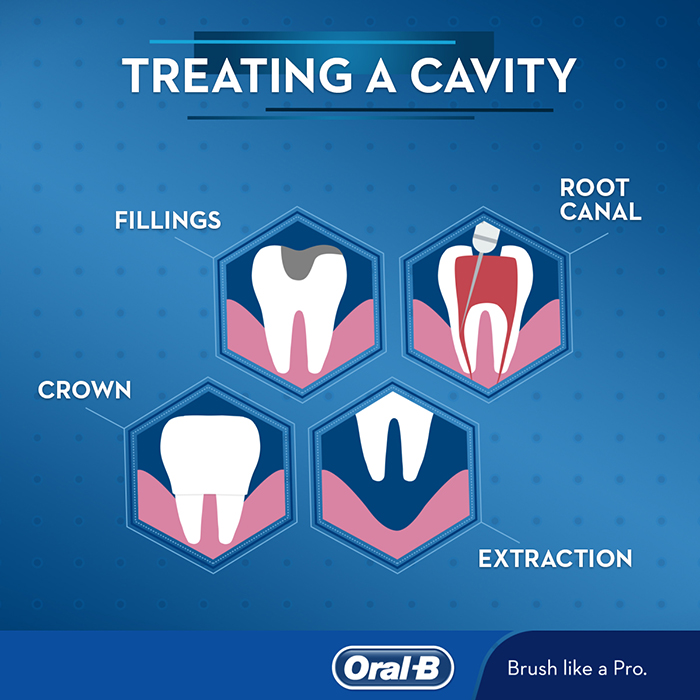Cavity Treatments: What are Ways to Treat Cavities?

Summary
Table of Contents

This blog has been reviewed and approved by Dr Robert Lee, a dental professional of 35 years
LEARN MORE >Cavities in teeth aren't just a painful inconvenience that you can just hope will go away. They require a specialized treatment that removes damaged tooth structure, repairs the tooth decay damage and puts an end to the pain. Here, we'll review the different courses of action that your dental professional may recommend to treat cavities.
Types of Cavities
When plaque is not removed by a consistent oral care routine of daily brushing and flossing, your teeth are more likely to develop cavities. Visit a dental professional regularly so he or she can check your teeth for any problems including cavities or gum disease symptoms.
Not all cavities are the same, and your dentist can tell you what type you have after examining your teeth with dental instruments. He or she may also use x-rays to confirm areas of decay.
The three types of cavities are:
- Root decay. This type of decay is the most common type among older adults who are more likely to have receding gums. It occurs on the surface of the roots of the teeth.
- Pit and fissure decay. This type of decay occurs on the chewing surfaces of the back teeth. It can be prevented with proper tooth brushing; however, if you're inconsistent in your oral hygiene, this type of decay can quickly become severe.
- Smooth surface decay. This type of decay occurs on the outside flat surface of the teeth when bacteria is not removed and plaque builds up. It's the least serious kind and may be treatable with fluoride. It's also helpful to know that this type of decay may be positively impacted by regular and proper dental flossing.
Cavities that tend to occur in the fissures on the chewing surfaces of the back teeth are called occlusal cavities. These cavities can occur on areas of the back teeth that are harder to get to when brushing; as a result, the grooves in the teeth may collect cavity-causing bacteria. Left on the teeth, these bacteria secrete acids which damage teeth surface—the process that creates cavities.
Cavity Treatments for Different Kinds of Cavities
Fortunately, there are a variety of treatment options available to address the problem of cavities on teeth. The treatment that is right for you is usually dictated by the severity of the cavity and can be selected only with the help of your dental professional who is able to best assess the severity of condition. Below, we'll discuss treatment options from the least to the most severe cavities.
The most common form of treatment for moderate to severe cavities are fillings. When you get a filling, your dental professional drills into the affected tooth, removes the decayed tissues inside the cavity, and completes the treatment by filling the drilled space with an appropriate material to restore the strength of your tooth structure. While the majority of fillings are made with composite resin, they can also be made of a variety of different materials. Occlusal cavities, or cavities on back teeth might be filled with more-durable materials, gold and silver being two options. For interproximal cavities, or cavities in between teeth, your dentist may opt for composite resin on visible teeth to address your aesthetic concerns and to provide a more attractive appearance. Based on the severity and location of your cavity, your dentist will know which is the best option for treating your cavities.
Saving Severely Infected Teeth with Crowns
For more extreme cases of tooth decay, when too much of the tooth structure is lost, your dental professional might opt for crowns. Sometimes a severely infected tooth requires large fillings, which can make teeth vulnerable to cracking, and ultimately breaking. To treat this level of damage, your dental professional will try to save what's left of the tooth, repair it and finally cover it with an alloy or porcelain crown.
Root Canals—Solution for Cavities that Damaged Tooth Nerves
When the damage from a cavity in your tooth goes too deep to be treated with the previous methods, your dental professional may suggest a root canal treatment. When tooth decay progresses through the tooth's protective enamel, it generally settles around the center of the tooth in the dentin. Decay that extensively penetrates the dentin may result in damage to the nerves in the tooth root and require a root canal treatment to address the problem. During the root canal procedure, your dentist will remove the damaged nerve and its surrounding blood vessel tissue, or pulp and fill the area with an endodontic sealant. If a large part of the tooth is filed away during the root canal procedure, your dental professional might decide to place a crown over the affected tooth once the procedure is complete.
Extraction as a Last Resort
Another cavity treatment, tooth extraction, is usually a last option when the aforementioned treatments are not sufficient to solve the problem. This option is only explored if destruction of the tooth tissues increases the potential of infection spreading to the jaw bone. For decayed teeth that are easily accessible, your dental professional will perform a simple extraction that does not require incisions or general anesthesia. A tooth extraction will leave an edentulous area, or gap between teeth, which may be remedied by inserting a partial denture, bridge or implant where the tooth was.

Can Cavities Go Away?
In the fight against cavities, following a good daily oral care regimen is the best course of action. It's worth noting that decay might be reversible with regular brushing and fluoride. Enamel can repair itself by using minerals from saliva and fluoride from toothpaste or other sources. An anti-cavity fluoride toothpaste and electric toothbrush are powerful tools for getting the most out of your routine.
- Find the right toothbrush for you: Oral-B® Electric Toothbrushes have perfect options for everyone from teens to adults. Many dentists recommend an Oral-B electric toothbrush because they feature technology that oscillates, rotates, and pulsates to better break up and remove plaque from teeth. Brushing can be improved by using an advanced brush head with an electric toothbrush, such as the Oral-B CrossAction brush head, which removes up to 100% more plaque along the gum line compared to a regular manual toothbrush.
- Brush for two minutes twice a day: Spend at least 30 seconds on each quadrant of your mouth. Brush daily for about 2 minutes, taking care to clean every surface of every tooth.
- Use a fluoride toothpaste and rinse: Fluoride has been proven to enhance dental health. Most importantly, dental professionals recommend using fluoride toothpaste, which is proven to greatly reduce cavities by strengthening the hard tissues of your teeth. If you are at a higher risk of developing caries, your dental professional may also recommend a fluoride mouthwash and daily flossing as a part of your oral health care regimen. For an extra level of protection against cavities, consider discussing if you need a professional fluoride treatment when you visit your dental office next time.
- Don't forget to floss: Remove food particles and plaque that brushing may miss.
- Visit your dental professional for a checkup twice a year: Having a professional cleaning and polishing not only keeps your smile bright, but is also an opportunity to have stubborn plaque and tartar removed. A thorough visual exam will reveal small issues before they develop into bigger ones, and X-rays show potential problems that the naked eye can't detect. And don't forget, your dental professional is also a great source of advice about the best oral care products for you.
Table of Contents
- Types of Cavities
- Cavity Treatments for Different Kinds of Cavities
- Can Cavities Go Away?
-
- Related Articles

This blog has been reviewed and approved by Dr Robert Lee, a dental professional of 35 years
LEARN MORE >
Sign Up
for plaque removal tips, expert advise, and exclusive offers.

Sign Up
for plaque removal tips, expert advise, and exclusive offers.







